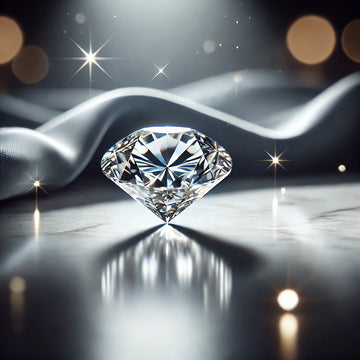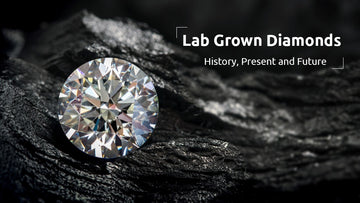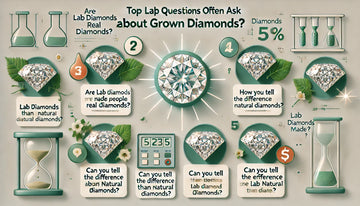Lab Grown Diamonds
Why Lab-Grown Diamonds Are the Future of Fine Jewelry
by Keyur Koshiya on Nov 23, 2024

Lab-Grown Diamonds: The Future of Fine Jewelry
Introduction
- Definition of lab-grown diamonds: Chemically, physically, and optically identical to natural diamonds but created in controlled environments.
- Brief history: From their inception in the 1950s for industrial use to modern advancements for fine jewelry.
- Rising popularity: Sustainability, affordability, and ethical sourcing as key drivers.
https://ivevar.com/products/high-end-925-silver-lab-grown-diamond-eternity-band-by-ivevar
The Science Behind Lab-Grown Diamonds
-
How They’re Made:
- High-Pressure High-Temperature (HPHT): Mimics Earth’s natural diamond-forming conditions with intense heat and pressure.
- Chemical Vapor Deposition (CVD): Uses carbon-rich gas to form diamond crystals layer by layer in a vacuum chamber.
- Comparison to mined diamonds: Both are composed of pure carbon atoms arranged in a cubic crystal structure.
- Key differences: Formation process and environmental footprint.
Why Choose Lab-Grown Diamonds?
-
Ethical Advantages:
- No association with conflict zones or unethical labor practices.
- A socially responsible alternative for consumers.
-
Environmental Benefits:
- Less energy-intensive and no land displacement or mining.
- Lower carbon footprint compared to traditional diamond mining.
-
Affordability:
- Lab-grown diamonds cost 30–50% less than mined diamonds of the same quality.
- Higher carat weight or better clarity and cut for the same budget.
-
Customization:
- Precision in creating unique shapes, sizes, and colors.
- Ideal for bespoke jewelry designs.
Debunking Common Myths
-
“They Aren’t Real Diamonds”:
- Lab-grown diamonds are certified by gemological institutions (e.g., GIA, IGI).
- They possess identical properties, including hardness and brilliance.
-
“They Have No Resale Value”:
- Increasing acceptance in the resale and secondary market.
- Ethical appeal and growing demand boost their long-term value.
-
“They Lack Quality”:
- Lab-created diamonds are graded on the same 4Cs (carat, cut, clarity, color) as mined diamonds.
- Precision technology often results in fewer inclusions and higher clarity grades.
Lab-Grown Diamonds vs. Natural Diamonds
-
Appearance:
- Indistinguishable to the naked eye; even gemologists require specialized equipment.
-
Price Comparison:
- Natural diamonds maintain a higher market value due to rarity and traditional appeal.
- Lab-grown diamonds provide better affordability for modern buyers.
-
Sustainability and Ethics:
- Lab-grown diamonds lead in eco-friendliness and conflict-free sourcing.
-
Emotional Value:
- Changing perceptions: Younger generations prioritize sustainability over traditional symbolism.
-
Longevity and Durability:
- Both types rank 10 on the Mohs scale, ensuring they withstand daily wear.
Applications of Lab-Grown Diamonds
-
Engagement Rings and Wedding Bands:
- Increasingly popular among eco-conscious couples.
- Offers flexibility for intricate, custom designs.
-
Fashion Jewelry:
- Available in various colors (blue, pink, yellow) for statement pieces.
-
Industrial Use:
- Hardness and thermal conductivity make them valuable for cutting, grinding, and electronics.
The Market for Lab-Grown Diamonds
-
Rising Demand:
- Young, socially conscious consumers driving the shift.
- Transparency in sourcing aligns with global trends in ethical luxury.
-
Jewelry Brands Adopting Lab-Grown Diamonds:
- Notable names incorporating them into collections.
- Customization and branding strategies to appeal to diverse audiences.
-
Challenges in the Market:
- Overcoming traditionalist biases.
- Educating consumers on their benefits and authenticity.
How to Buy Lab-Grown Diamonds
-
Look for Certification:
- Verify authenticity with grading reports from IGI, GIA, or AGS.
-
Understand the 4Cs:
- Choose a balance of carat, cut, color, and clarity to suit your preferences.
-
Work with Reputable Jewelers:
- Partner with brands committed to transparency and ethical sourcing.
-
Customization Options:
- Explore design services for personalized jewelry pieces.
The Future of Lab-Grown Diamonds
-
Innovation in Technology:
- Continued advancements in CVD and HPHT processes.
- Potential for creating even larger and more unique stones.
-
Changing Consumer Preferences:
- Sustainability becoming a central value in luxury markets.
- Younger generations redefining “luxury” with ethical and eco-conscious choices.
-
Integration into High Jewelry:
- Acceptance by luxury houses and mainstream adoption.

 Engagement Ring
Engagement Ring  Anniversary Rings
Anniversary Rings Solitaire Rings
Solitaire Rings Halo Rings
Halo Rings Men's Ring
Men's Ring Toi Moi Ring
Toi Moi Ring Three Stone Rings
Three Stone Rings Nature Inspired Rings
Nature Inspired Rings Rose Cut Diamond Rings
Rose Cut Diamond Rings Fancy Color Rings
Fancy Color Rings Antique Cut Diamond Rings
Antique Cut Diamond Rings Wedding rings
Wedding rings All Lab Grown Diamond Ring
All Lab Grown Diamond Ring Engagement Ring
Engagement Ring  Three Stone Rings
Three Stone Rings Daily Wear
Daily Wear Fancy Color Rings
Fancy Color Rings Antique Cut Diamond Rings
Antique Cut Diamond Rings Earrings
Earrings Bracelet
Bracelet Pendent
Pendent Necklace
Necklace Men's Ring
Men's Ring Bridal Sets
Bridal Sets Rings
Rings Earrings
Earrings Tennis chain
Tennis chain Custom Pendent
Custom Pendent Custom Ring
Custom Ring Custom Teeth Grillz
Custom Teeth Grillz Round
Round Oval
Oval Cushion
Cushion Marquise
Marquise Pear
Pear Emerald
Emerald Heart
Heart Princess
Princess Rose Cut
Rose Cut Radiant
Radiant Antique Cut
Antique Cut



